Once Upon a Time There Was a Farmer Whose Family Raised Pigs and Chickens. One
Inside Polyface Farm, Mecca of Sustainable Agronomics
A writer joins hordes of farmers and tourists for a in one case-every-iii-years look at Joel Salatin's pioneering "grass-farming" functioning
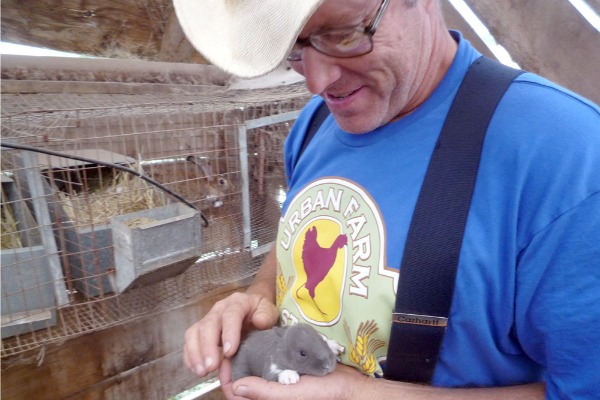
Two weeks agone, I joined about 1,700 farmers, foodies, and families from across the U.S. for a pilgrimage to Joel Salatin's Polyface Farm, abode of his iconic model of local, sustainable agronomics.
Salatin, the loftier priest of "grass-farming," every bit he defines his work, hosts a field day every 3 years on his 550-acre spread in Swope, Virginia, in the hills of the Shenandoah Valley. Visitors have come from as far away as Florida and Iowa to trudge through the thick, soft pastures and see how Salatin raises cows, chickens, pigs, rabbits, and poultry. It is a brilliant sunny twenty-four hour period, warm already at 8 a.yard. on a Sat.
Walking upwardly a gentle slope, nosotros come up upon a herd of cows "mobbed" under a shady canopy, nibbling grass and depositing patties of natural fertilizer in the acre-or-so where they have been herded for the day. Tomorrow the white plastic electric fence—so thin information technology is hard to meet in the brilliant sunlight—will be moved, the cows transferred to a new paddock so they tin feast on a fresh "salad bar." Nearby, the chickens, in their big, floorless, corrugated tin-and-mesh mobile playpens are pecking at the cow patties left past the previous day'due south mob, picking out the wing larvae, aiding the composting process. Similar so much on the farm, it is a virtuous wheel, the cows and chickens working together to create the rich soil, grass, and insect ecosystem.
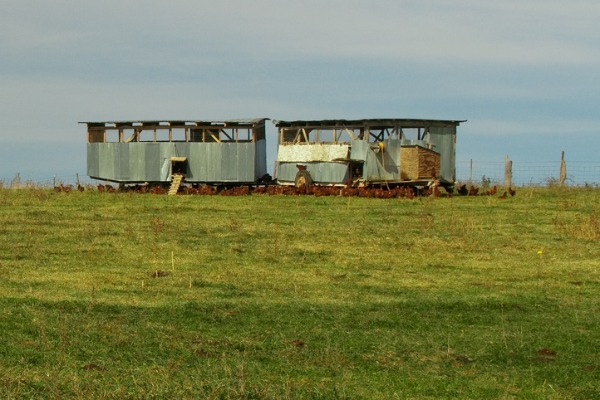
Nosotros cross over to a glen, where the pasture meets the woods: at near 400 acres, forest covers well-nigh of the belongings, which now supports three generations of Salatins, including Lucille, Joel's widowed mother, who bought the land with her husband, William, in 1961. Hither, more high-tech, hard-to-see fencing contains a herd of pigs, who are snuffling every bit they search for acorns, hickory nuts, grubs, and worms. "They disturb it, churn it up," explains Salatin, for whom "disturbance" is the key to fertility and regeneration.
It is also a good fashion to depict the mission of Salatin, who describes himself as a "Christian-libertarian-environmentalist-lunatic farmer"—one who rails against industrial agriculture and government, and proselytizes about reconnecting consumers and farmers. ("Polyface doesn't participate in authorities programs," has no mortgage, and eschews organic certification, says Salatin, a former journalist whose new book, Folks, This Ain't Normal, is coming out this fall.)
On Polyface, information technology's the pigs that best embody Salatin's ideas of creative disturbance, as well as his holistic, waste-not-want-not management approach. As Salatin sees information technology, pigs have a plough at the end of their noses and a sign on their foreheads that reads "will work for corn,"—traits that make them ideal for mimicking the buffalo that in one case marauded through the surface area, turning the soil and creating fertile pastures. Similar the cows, the pigs are rotated regularly. No paddock is occupied more than in one case per year, assuasive the forest to regenerate.
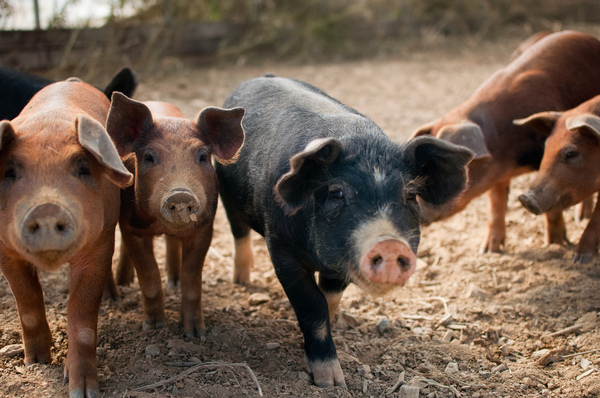
Up the hill is the "pigaerator," a fundamental to why Polyface requires no chemical fertilizer or seed. Nosotros oversupply below the tall metal-and-plastic canopy of an open-air barn-like structure—similar many Polyface constructions, it was congenital of crude-hewn local oak and rot-resistant locust trunks. The pigaerator is actually a cattle-feeding station: ane side is piled loftier with hay; the other side contains troughs on vertical chains with pulleys.
During the winter, when the grass disappears, the cows eat hay at the feeding station, depositing tons of manure and urine on a "giant carbon diaper" of hay, wood chips, and saw dust. Instead of mucking out the shed, the Salatins layer more bedding on top, adding corn into the mix. The cows stamp out the oxygen. The corn ferments. By March, the bedding pack tin can reach as high as 4 feet, raising the floor of the shed along with the cows—hence the pulleys.
In the early spring, when the cows return to pasture, the pigs movement into the shed, digging for fermented corn and, in the process, aerating the bedding. In lieu of the giant machines used in windrow composting, Salatin relies on low-cost pig ability to create natural fertilizer to feed the land. In that location is no manure-related pollution. No smell. No disease. No costly fertilizer.
Ane of the nearly striking things about the Polyface operation is its remarkable cleanliness. In that location are relatively few flies or mosquitoes—a surprise, considering the hundreds of grazing and pecking animals. Nor are at that place whatever obnoxious odors.
Best of all, Salatin says, his system lets animals roam relatively freely and behave as nature intended them to. It "fully honors the pigness of the pig."
As he does oft during the bout, Salatin digresses to matters more spiritual and political than agricultural: "The pig is not just pork chops and bacon and ham to us. The sus scrofa is a co-laborer in this nifty state-healing ministry building.
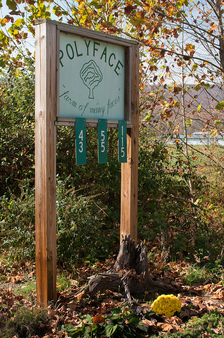 "Our culture doesn't ask about preserving the essence of pig, it merely asks how tin we abound them faster, fatter, bigger, and cheaper. We know that's non a noble goal. That's why the boilerplate NFL football game histrion is dead at 57, 'cause when your neck is bigger than your head you're a freak of nature and nature weeds you out."
"Our culture doesn't ask about preserving the essence of pig, it merely asks how tin we abound them faster, fatter, bigger, and cheaper. We know that's non a noble goal. That's why the boilerplate NFL football game histrion is dead at 57, 'cause when your neck is bigger than your head you're a freak of nature and nature weeds you out."
Laughter fills the shed.
"Nature moves towards balance," Salatin intones. "I would suggest that a culture that views life from that kind of disrespectful arrogant standpoint volition view its citizens the same fashion and other cultures the same means."
"Amen," says a woman adjacent to me; she is breast-feeding i of the iv small children with her.
Salatin opens the floor to questions, of which there are many. Tin he quantify the soil gains from the acorn glen? (Not nonetheless, though Salatin knows there is more biodiversity here than on his neighbors farms.) How much salt does Salatin put in the hay? (20-v to 35 pounds per ton.) How, without using fertilizer, does he control weeds?
Salatin pauses before countering: "Yous recall my pastures are weedy?"
"Yep, I do" is the response.
"Okay, well I don't," Salatin says, noting that thistles are just almost the simply matter his cows won't eat. "If they are control grazed tightly in a mob, they will swallow things you will never believe they'll eat with bask, gusto," he adds.
With that, Salatin invites us to tiffin. Heading back through the pasture, I pass a Mennonite family from Ohio. I conversation with Bryna Fisher, whose family—recovering "metropolis-folk"—take bought a farm in southern Illinois and are "learning as nosotros get."
Lunch is a barbecue of Polyface chicken, beefiness, and pork, with sides of cucumber and peaches. We eat perched on bales of hay under another open-air barn, where I encounter Gregg Korbon, an anesthesiologist from Charlottesville, and his 15-year-onetime son Matthew, who tells me that the $50,000-rabbit operation run by Daniel Salatin, Joel's grown son, has inspired him to raise rabbits.
After lunch, I stop by the airy "rakin" (rabbit-chicken house) to larn more most the rabbits. There I meet Roberta Pineda, who tells me, in Spanish, that her family owns two local taquerias. They have come to run across about ownership meat from Polyface because of its superior "calidad." Local Chipotle branches already buy from the farm.
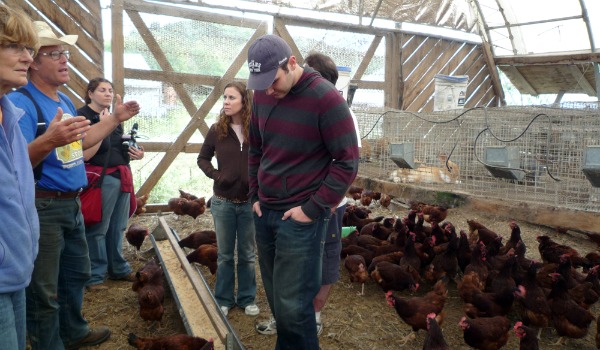
The visitors this field day include a bigger contingent of foodies, including at least one chef (Brian Robinson of Washington, D.C.'s Eating place 3), than those of earlier years. But the majority are farmers. The Salatins don't rail how many accept adopted Polyface methods, but Daniel Salatin concedes that the numbers are relatively small. "Change is hard," the younger Salatin says. That's particularly true for those who have invested in the costly infrastructure of traditional farming. So too, he adds, "We're not endorsed by the powers that be," the extension services that give farmers advice or the salesmen who shape the lion'southward share of the decisions farmers make.
Some other obstacle is lenders. James Showalter farms a 530-acre spread about xx minutes away from Polyface and is one of the few farmers in the surface area who has at least partially "Salatinized" his subcontract. After years in the dairy business organisation, Showalter now raises a diversity of animals and crops. He has a modest mortgage on his property, but, he says, he can afford to experiment considering he is less dependent on lenders than many farmers. "The lending institutions need to be able to open a text book and bring up averages," Showalter says. "And there are no averages on a pioneer. In that location's no manner a lending agency tin can know what to await" from these methods.
Indeed, while Salatin tin quantify the gains from some methods—his pigs dig enough nutrient up off the woods floor to substitute for equally much as $500 of feed per year—there are many more things, like the value of regenerating his forests via pig rotations, that are harder to quantify.
Nor are Polyface'southward methods for everyone. For example, Showalter initially, closely followed the Polyface approach to raising chickens, but presently decided to give his poultry more room to roam; his chickens, he insists, are healthier than Salatin's considering they can exercise. By contrast, although he tried, and eventually abandoned, a pigeraetor, he thinks that Polyface'due south arroyo to raising pigs is superior to his own.
Showalter is also in awe of Salatin'southward marketing ability.
Polyface, with 900 head of cattle and about 700 pigs, is growing fast. Revenues this year volition top $two million, nearly double the figure five years ago, says Salatin, who has expanded by leasing seven local farms, which are run by former Polyface interns and apprentices, many of whom are at field day, identifiable past their matching sky-blue polo shirts. Salatin is not sure when information technology volition be fourth dimension to end growing, but he'south sticking to ten cadre values that he says will proceed him from ever being "Wall Streetified," including never setting a growth target and selling only to customers within a four-hour drive. The field day pilgrims, of course, have traveled much farther.
Images: First and last images via jessicareeder/flickr, all others dane brian/flickr
Source: https://www.theatlantic.com/health/archive/2011/07/inside-polyface-farm-mecca-of-sustainable-agriculture/242493/
0 Response to "Once Upon a Time There Was a Farmer Whose Family Raised Pigs and Chickens. One"
Post a Comment